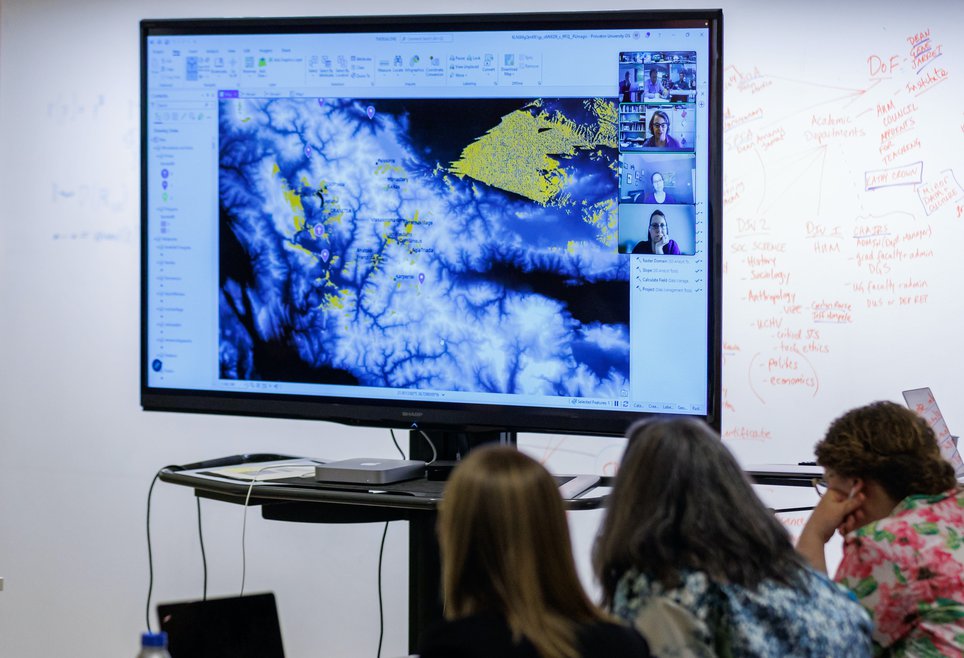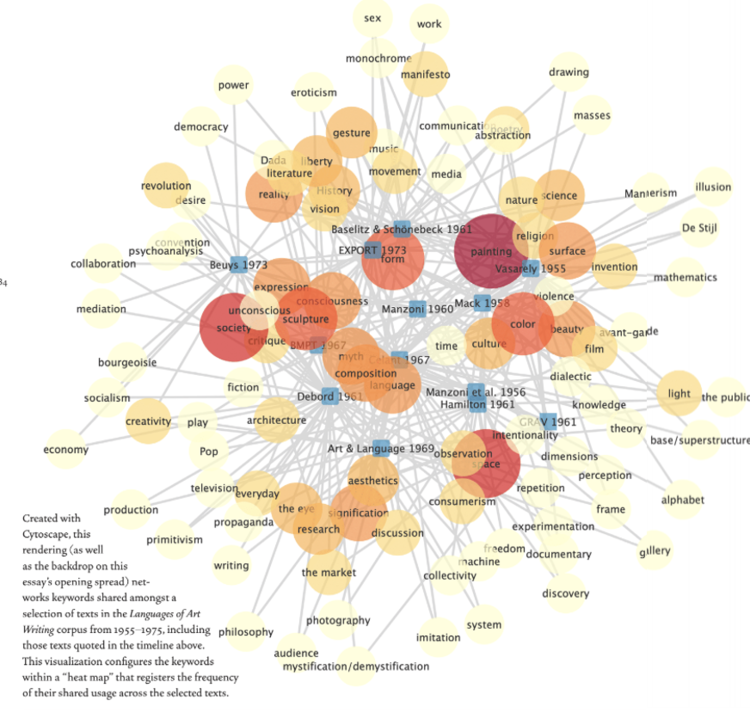Data Fellowship Closeout imparts collaborative discoveries, ongoing inquiry, and a new sense of confidence with data tools and methods
On Wednesday, May 17th, the CDH hosted the 2022–23 Data Fellowship Closeout Meeting with the presentations of seven vastly different, compelling projects by eight researchers. The occasion brought together the cohort after their year-long, CDH-supported fellowship. Each project director shared their initial goals, the successes and challenges of the applied data work, and the future plans for their projects. While results varied, the connective themes throughout their experience revealed a successful exploration in digital humanities practices and a foundation for new directions in their digital research.

2022-23 Data Fellows gathered around the CDH Classroom to present their projects to one another, staff, and guests.
Discovery through collaboration 🙌
Collaboration is a fundamental principle of research at the CDH. In particular, the Data Fellowship program reflects this through its many partner units, as well as the exchange and feedback between fellows and staff. The Closeout showed a variety of methods for gathering the desired data in each project, and teamwork played a significant part.
One project team that leaned into a collaborative practice is Sara Green and Nathan Stobaugh, a pair of Art & Archaeology graduate students who worked closely to make organizational decisions while contending with the vast complexities of art historical sources. Their project, Languages of Art Writing, is a database of the terminology employed in art criticism, artists’ statements, and manifestos published in Western Europe from the late 1940s to the present. Green and Stobaugh have created more than six hundred searchable keywords, cross-referenced with Library of Congress and Getty controlled vocabularies, to explore connections among conceptually linked texts. Over the course of their fellowship together, they developed this successful tagging process in Google Drive, co-authored a text in the MIT publication Thresholds, and visualized their data using Cytoscape. Green and Stobaugh closed their presentation with a supportive note of endorsement: “We hope other collaborative projects of various stripes might continue to find a home at the CDH.”
Through her project Shen Nanpin and the Problem of Authenticity, Caitlin Karyadi (Ph.D. Candidate, Art & Archaeology) is building a compilation of datasets for thousands of works attributed to Shen Nanpin, an eighteenth-century Chinese artist whose work became renowned in both China and Japan. She shared that the feedback she received from Emily McGinn (HC3 Curriculum Specialist, CDH), Leigh Lieberman (Digital Project Specialist, A&A), and Joshua Seufert (Chinese Studies Librarian, PUL) helped her to refine, clean, and add more entries to her dataset, providing further analysis that she will integrate into the third chapter of her dissertation.
Molly Greene (Professor of History and Hellenic Studies, History) attributes the successful execution of her project to the support of her assistant, Postdoctoral Researcher Lucas McMahon. Together they recorded hours of their conversations for referential purposes. This was integral to their project, The Monastery, the Bridge and the River, where they are attempting to understand the surprising importance of a seemingly peripheral and rugged environment during the Ottoman period: the Pindus mountain range, located in western mainland Greece.
What to ask the data / what to do with the data 🔮
Greene also expressed that in the process of generating her data, she wanted to be sure to have a good question for it. Just before her presentation, she arrived at a newly generated path in her mapping research and now knows exactly the question to ask of it. In realizing that this work is challenging and ongoing, she is excited to continue to build upon her map beyond the fellowship period.

Molly Greene presenting her mapping research over Zoom, using ArcGIS.
In Rachel Richman’s (Ph.D. candidate, Near Eastern Studies) analysis of deathbed gifts to and from women in medieval Cairo, she is seeking to identify patterns that illuminate women’s roles in the medieval Egyptian economy. Working with the CDH helped her develop her data more specifically: tracking the objects that were gifted, rather than solely the people who received them. This allowed her to compare the data more coherently across the corpus. Similar to Greene, finding the right questions to ask of the data presented a challenge. Ultimately, the data from her project Willing Prosperity will be part of a chapter of her dissertation on women’s labor and property in the Cairo Geniza, as well as a model to future historians hoping to analyze wills using computational methods.
CDH’s Digital Humanities Strategist, Grant Wythoff, raised the point that this work takes time, often longer than the year-long period of the fellowship. If the questions for the data had not yet revealed themselves, what other realizations or new perspectives surfaced along the way?
One fellow, Helmut Reimitz (Professor, History), whose project History Books and the History of the Book in the Middle Ages applies computational tools to learn about the “history of histories” in medieval Europe, mentioned that he was challenged to define more strict boundaries in his identification system due to the small size and relevance of some of the texts he was dealing with: around twenty manuscripts ranging from the mid-ninth to twelfth centuries.
In several cases, the fellows’ project data will become an open-source, archival record for the use of future scholars and researchers.
For example, Green and Stobaugh’s Languages of Art Writing could be used by undergraduate students to explore research topics through terminology and references derived directly from primary texts.
For Reimitz, his pilot database will serve as a test for a future, larger database of histories from the Carolingian period, with the aim to help scholars study how history books in regions throughout the (former) Carolingian world portrayed the past. He also hopes to introduce students to his datasets through his teaching.
Xin Wen (Assistant Professor, East Asian Studies and History), who is creating a dynamic map of the city of Chang’an—the largest city in the world for much of the first millennium CE—hopes to make his map accessible as an online resource for research and apply it to his teaching. The data will be used in his book-in-progress Chang’an: The Death and Rebirth of China’s Eternal Capital 900–1400 and his graduate seminar “Chang’an: China’s Medieval Metropolis.”
Confidence with data tools and methods 💪📊

Example of visualizing the Languages of Art Writing data set using Cytoscape (Image courtesy of Sara Green)
A definitive theme among the fellows was a deeper sense of confidence when using tools and methods to produce data. One prominent goal of the fellowship is to learn best practices in data selection, structuring, cleaning, transformation, and preservation, with the aim of producing a dataset suitable for computational analysis.
Karyadi shared that “designing an initial framework, routinely adding to the dataset, and then refining it based on usability and evolving goals” have unlocked new directions and questions in her research on Shen Nanpin. Starting at 600 entries and arriving at about 1,000 currently, she spent much of the past year acquainting herself with Excel and data management best practices.
Richman noted that learning how to use Tableau—thanks to Ryan Heuser (Research Software Engineer, CDH)—and further exploring Google Colab were positive outcomes of her work. One of her initial project goals was to produce visualizations that would end up in her dissertation.
Stephanie Luescher (Ph.D. candidate, Near Eastern Studies), successfully developed a functional relational database of manuscript annotations with the help of Rebecca Sutton Koeser (Lead Research Software Engineer, CDH), which will support her dissertation writing process. Her project, Taking Note, traces the “bookish endeavor” of Muhammad al-Muzaffarī (Cairo) through the notes he left behind on hundreds of manuscripts, and examines the broader book culture of the Cairene scholarly community in the late 15th and early 16th centuries. Luescher also expressed that the experience gave her confidence in data structure and the results that she will be able to draw from it.
With support from Wythoff, McGinn, and Tsering Wangyal Shawa (Geographic Information Systems Librarian), Wen utilized QGIS–an open-source geographic information application—to visualize and analyze how Chang’an changed over time, specifically the dynamic process of urban change and how places overlap and coexist at some points in history.
Similarly, Greene was pleased to have learned ArcGIS, web-based mapping software, as she plans on scaling her project in the months and years to come.
CDH Data Fellowships are open to Princeton faculty, staff, graduate students, and postdoctoral fellows from any discipline interested in exploring the analytical and technological practices of working with humanities data. For more information on applying, visit: cdh.princeton.edu/engage/grants/cdh-data-fellowships.